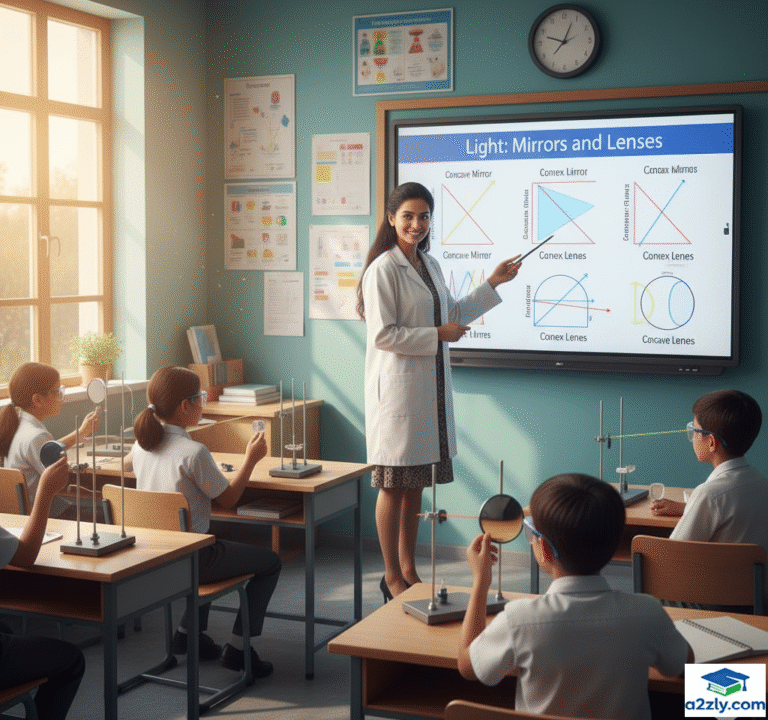🧭 Chapter Overview
Light plays a vital role in our daily life — from the reflection you see in a mirror every morning to the lenses in your spectacles or camera. This chapter, “Light: Mirrors and Lenses,” introduces you to the fascinating science of how light interacts with surfaces and materials.
You’ll learn about different mirrors (plane, concave, convex), how lenses bend light, and how real-world devices like car mirrors, eyeglasses, and telescopes work.
By the end of this lesson, you’ll see how physics and daily life beautifully reflect one another — quite literally!
Table of Contents
🎯 Learning Objectives (NEP 2025 Competency Table)
| Competency | Learning Outcome | NEP Skill |
|---|---|---|
| Conceptual Understanding | Explain laws of reflection and refraction | Conceptual Clarity |
| Analytical Thinking | Differentiate between concave and convex mirrors/lenses | Critical Analysis |
| Application | Apply concepts to real-world uses (mirrors, telescopes, eyeglasses) | Practical Knowledge |
| Experimentation | Observe and record image formation | Inquiry & Scientific Method |
| Values Integration | Recognize India’s ancient optical knowledge | Cultural Awareness |
🌟 10.1 What Are Spherical Mirrors?
Hold a shiny spoon near your face — you’ll see two different kinds of reflections:
- The inner curve gives an inverted and enlarged image.
- The outer curve gives a small, upright image.
That’s because the spoon acts as a spherical mirror — a mirror shaped like a part of a hollow sphere.
🪞 Types of Spherical Mirrors
| Type | Reflecting Surface | Appearance | Example |
|---|---|---|---|
| Concave Mirror | Curved inward (like a cave) | Enlarges objects when close | Shaving mirror, dentist’s mirror |
| Convex Mirror | Curved outward | Shows smaller, wider images | Car side-view mirror |
⚙️ Real-Life Connection
- Concave mirrors concentrate light — used in torches, car headlights, and solar cookers.
- Convex mirrors spread light — used as rear-view mirrors and safety mirrors in stores and roads.
Did You Know?
Convex mirrors in vehicles carry the message —
“Objects in mirror are closer than they appear.”
That’s because convex mirrors form smaller, distant-looking images while showing a wider field of view.
🌈 10.2 How Do Mirrors Form Images?
The shape of a mirror determines how it reflects light and forms an image.
Concave Mirror:
- Object near mirror → Image enlarged, upright.
- Object far → Image inverted and smaller.
Convex Mirror:
- Image always upright, smaller, and virtual.
| Mirror Type | Image Nature | Image Size | Image Orientation |
|---|---|---|---|
| Plane | Virtual | Same size | Upright |
| Concave | Real or virtual | Enlarged or diminished | Upright (close) / Inverted (far) |
| Convex | Virtual | Diminished | Upright |
🧪 Activity Corner
Try This:
Place a candle in front of a concave mirror in a dark room. Move it closer and farther.
→ You’ll see the candle’s image change from large and upright to small and inverted — a visual proof of how image distance affects reflection.
🔍 10.3 Laws of Reflection
All mirrors follow two universal laws of reflection — whether plane, concave, or convex.
1️⃣ Law 1 – Angle of Incidence = Angle of Reflection
(The light ray hits and reflects at equal angles.)
2️⃣ Law 2 – The Incident Ray, Reflected Ray, and Normal All Lie in the Same Plane
Example Experiment:
Shine light from a torch through a slit (using a comb and black paper).
Observe how the reflected beam always obeys these laws — even if you tilt the mirror!
| Quantity | Symbol | Definition |
|---|---|---|
| Angle of Incidence | i | Between incident ray & normal |
| Angle of Reflection | r | Between reflected ray & normal |
✅ For all mirrors: i=ri = ri=r
🧩 Reflection in Spherical Mirrors
- Concave mirrors → Converge light rays (focus them together)
- Convex mirrors → Diverge light rays (spread them apart)
This is why concave mirrors can focus sunlight to a point — a concept used in solar furnaces and solar cookers.
☀️ Real-Life Application – Solar Concentrators
Concave mirrors in solar devices reflect and focus sunlight on a small area, generating intense heat used for:
- Cooking food (solar cookers)
- Melting metals (solar furnaces)
- Producing electricity (solar plants)
🔍 10.4 What Are Lenses?
While mirrors reflect light, lenses bend (refract) it.
A lens is a transparent material (usually glass or plastic) with curved surfaces that refract light to form images.
🧪 Types of Lenses
| Type | Structure | Function | Example |
|---|---|---|---|
| Convex Lens | Thicker at center, thinner at edges | Converges light rays | Magnifying glass, human eye |
| Concave Lens | Thinner at center, thicker at edges | Diverges light rays | Used in eyeglasses for near-sightedness |
👁️ Everyday Examples
- Convex Lens → Magnifying glasses, cameras, telescopes, microscopes.
- Concave Lens → Eyeglasses for myopia (short-sightedness).
🔬 10.5 Image Formation Through Lenses
When you look through a convex lens, the object appears enlarged and upright if close, but inverted when far.
Through a concave lens, the image is always upright and smaller.
| Lens Type | Image Nature | Size | Orientation |
|---|---|---|---|
| Convex | Real/Virtual | Enlarged or reduced | Erect (near) / Inverted (far) |
| Concave | Always Virtual | Diminished | Erect |
🔥 Activity: Light Beam & Lens Experiment
- Shine parallel light beams using a torch and comb.
- Direct them through:
- Glass Plate → Light passes straight.
- Convex Lens → Light converges.
- Concave Lens → Light diverges.
This explains why a convex lens is called a converging lens, and a concave lens is a diverging lens.
☀️ Can a Lens Burn Paper?
Yes! A convex lens can focus sunlight to a point, generating enough heat to ignite paper.
This principle is also used in solar magnifiers and lens-based solar cookers.
⚠️ Safety First: Never look directly at the Sun through a lens.
🪶 10.6 Uses of Mirrors and Lenses in Daily Life
| Device | Type Used | Function |
|---|---|---|
| Shaving Mirror | Concave | Enlarges face for a close shave |
| Vehicle Rear-view | Convex | Provides wider field of view |
| Dentist’s Mirror | Concave | Enlarged image of teeth |
| Magnifying Glass | Convex | Enlarges text or objects |
| Spectacles | Concave/Convex | Correct vision |
| Telescope | Concave Mirror + Convex Lens | View distant objects |
| Camera Lens | Convex | Focuses light to form image |
🧬 Our Scientific Heritage
Over 800 years ago, Indian astronomers during Bhāskara II’s era used reflection from water surfaces to measure star positions.
Even without written laws, their instruments reflected an advanced understanding of optics — proof that ancient India contributed deeply to light science.
🧠 HOTS (Higher Order Thinking Skills)
- Why does a concave mirror form an inverted image when the object is far away?
- Why do convex mirrors show smaller but wider images?
- Why is a convex lens used in magnifying glasses but not a concave one?
- What happens to the focal point of a mirror when temperature changes?
- Why does a pencil appear bent when placed in water?
⚙️ NEP COMPETENCY FRAMEWORK
| Learning Domain | Competency | Example Application |
|---|---|---|
| Conceptual | Understanding reflection & refraction | Explain mirror images |
| Analytical | Compare mirror/lens behavior | Object distance analysis |
| Practical | Conduct light experiments | Verify i = r law |
| Ethical | Historical appreciation | Bhāskara II optics |
| Creative | Design project | DIY solar cooker model |
📘 Snapshots (Quick Recap)
✅ Concave Mirrors → Converge light, enlarge or invert images
✅ Convex Mirrors → Diverge light, always form small, erect images
✅ Laws of Reflection → i = r, all rays lie in one plane
✅ Convex Lenses → Converging lenses (used in eyes, cameras)
✅ Concave Lenses → Diverging lenses (used in spectacles)
✅ Ancient India’s Optics → Bhāskara II’s reflective astronomy
⚠️ Exam Alert Box
❗ Frequently Asked 3-Mark Question:
Explain how convex and concave mirrors differ in image formation and give one use of each.
❗ Remember:
Laws of reflection apply to all mirrors — plane, concave, and convex.
💡 Memory Booster Box
🔹 Concave = Converge (mirror)
🔹 Convex = Diverge (mirror)
🔹 Convex lens = Converge light
🔹 Concave lens = Diverge light
🔹 Law: i = r
🔹 Solar devices use concave mirrors and convex lenses.
🔗 INTERNAL & EXTERNAL LINKS
Internal Links (A2ZLY):
- Chapter 9 – The Amazing World of Solutes, Solvents, and Solutions Notes 2025
- Class 8 Science All Chapters Smart Notes (NEP 2025 Edition)
- Smart Notes Creator NEP 2025 Hub | A2ZLY
External Links:

